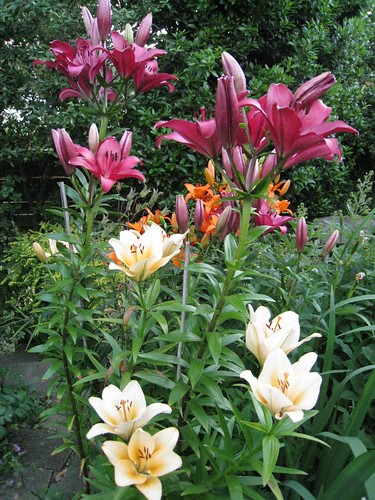Some days it can feel like I’m always on, always connected, always plugged in.
But really, I think it’s a mixture. Being plugged in isn’t necessarily any better or worse than not being plugged in.
Unplugged: I enjoy my morning walks with M. We chat. I listen to my surroundings, enjoy the air, feel my body move. A nice prelude to a busy day in the office. I miss these walks on the mornings either of us has something else on.
Plugged in: on the train I am never completely alone, as I spend the time communicating with and chatting with others over Twitter. I read their stuff, retweet, make notes, ask questions, think.
Unplugged: talk with colleagues and plan a project, sketch timelines on paper with a fountain pen. I could do this on a device, but I love the flow of ink across clear paper. Transcribing it into a digital format later, I recall what was discussed, add to my ideas.
Plugged in: listening to music. I use Spotify and Pandora to compare versions of a favourite symphony.
Plugged in: I read bloggers rhapsodising about a latest novel. I borrow an electronic copy immediately, from the public library.
Unplugged: I spend hours reading said novel on my ereader. No distractions.
Unplugged: my nieces and nephews play and cuddle chihuahuas. They draw pictures, practice handwriting, are read to.
And so on…
Jan Holmquist suggested that being able to have different levels of plugged-in-ness is useful and important. I like his levels:
Code Red: Total unplug. No twitter, No email, No facebook etc
Code Orange: I don’t read tweets and don’t tweet but I answer direct messages, and email. I will not catch up on feeds when I’m plugged again.
Code Yellow: I might read and share stuff but I will not be updated on everything in my feed. This will be a broadcast and answer only. Not the best way to use social media – but for taking an inspirational reading day -it might work fine.
Code Green: Plugged…
I do find it interesting that Jan’s chosen red for unplugging, and green for being plugged in. I suppose unplugged red because you come to a stop, slow down, do non-connected things. Green, when you’re back on board and all systems on again.
Depending on your frame of mind, though, you could swap, and use green for unplugging and red for being plugged in. Green for unplugging because you are using the time to recharge, to have time out. Red when you’re plugged in again and busy busy busy with all systems on high alert…
I don’t go to Code Red often at all. The last time I tried this it was very hard, mainly because I rely on all my networks so heavily to stay in touch with friends and family. I imagine the next time I do it will be when I’m on holidays and the network is unreliable or unavailable. I haven’t got any such holidays planned, though, so this is mere speculation at this point!
I find that on many weekends I do actually switch to a combination of Code Yellow and Code Orange. I definitely minimise my email access on weekends, and I don’t worry too much about keeping up with everything.
Do you unplug?

7 Comments
yes I do. And I often sit in the Code yellow-green continuum especially if I’m overwhelmed with stuff but I want to stay connected to consume rather than create content.
I think it’s good to unplug from time to time. We can have great insights just by taking a walk, for example. Both codes orange and yellow work fine for me.
I think you could call me multi-coloured 😉
Only if my battery dies. Or maybe for an hour if I’m at e.g. a wedding, or perhaps linger if I’m reading a book. So much of my life is lived online, it’s just another space.
Thanks for this post – and for the mention… Reminded me it has been too long since I have unplugged…
My reasons for choosing the unplugged colours like I did was because I imagined them being part of social networks – so when I went code red – Twitter would display a little red icon meaning “Do not disturb” 🙂 – I must admit that I like the way you think about it better – because this is a thing you do for yourself – therefore the colours should reflect what is in it for you – So from now on I will think code red as stop – slow down…